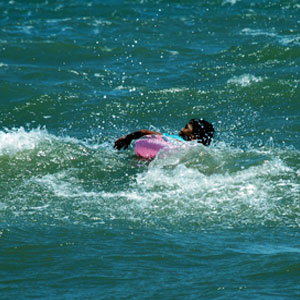With more than 7,100 islands, the Philippines is a tourist spot in Asia surrounded by beaches, hot springs, rivers, or lakes, which are the favorite summer getaways of vacationers. Some of these are a couple of hours’ drive giving the swimming lovers the chance to beat the summer heat.
Before you start diving into the oceans and enjoy sun-bathing in the beaches, how you ever wondered how safe and prepared are you in these places?
Swimming Lessons
Let’s take a look if safety tips in swimming classes are incorporated in physical education in the Philippine curriculum. The Department of Education’s Basic Education Curriculum requires that physical education be taught in schools once a week for 40 minutes. However, this will certainly not develop students to be proficient in any sport they desire. Only a handful of Philippine schools have swimming pools and the basic swimming strokes are not given much emphasis. This means that many people are not drown-proof.
 Larry Alag, secretary general of Philippine Life Saving (PLS), a governing body for water safety in the Philippines, and a full member of International Life Saving (ILS), says: “As an archipelagic country, most Filipinos travel by ship, roro, or small bancas (boats). In the past years, we experienced some maritime disasters brought by typhoons that hit the country.”
Larry Alag, secretary general of Philippine Life Saving (PLS), a governing body for water safety in the Philippines, and a full member of International Life Saving (ILS), says: “As an archipelagic country, most Filipinos travel by ship, roro, or small bancas (boats). In the past years, we experienced some maritime disasters brought by typhoons that hit the country.”
According to the Philippine Coast Guard Board of Maritime Inquiry and Marine Protests, from 1990 to 1999, there were 338 water accidents, and four years after the figure increased to 395 maritime incidents. From these, countless people drowned and died.
Preventive Measures
Alag says drowning can be prevented. During the World Water Safety Congress in Berlin, ILS experts stress that prevention (not rescue operation or resuscitation) is the most effective way in reducing drowning cases. In a related study conducted by the group, there is a link between the drowning and water safety education. The experts claim that there is a need to implement the right programs by introducing water safety education among elementary and high school students.
Mark Joseph, president of the Philippine Amateur Swimming Association, notes: “Swimming is a way of life. If we are pro-life, then it is high time that we teach our kids how to properly swim. Unable to do this is a major security issue for our families and communities. “Filipinos must learn the basic of water safety, swimming and survival skills, and monitor their progress from there,” Alag says.
 To initially teach the kids the basics of swimming, PLS has established a ‘Swim and Survive’ program, which was awarded by Royal Life Saving of Australia. Swim and Survive is an ILS’ recommended program as the best practice in learning how to swim. This teaches the required swimming skills, personal survival tips, basic rescue activities, and endurance test. Families can visit any Philippine Life Saving Center to learn basic survival swimming skills.The program has been launched in all Philippine Life Saving Centers in the major cities in the country. In June 2008, PLS has trained 50 Elite Bronze Medallion Instructors and 1,500 life-savers.
To initially teach the kids the basics of swimming, PLS has established a ‘Swim and Survive’ program, which was awarded by Royal Life Saving of Australia. Swim and Survive is an ILS’ recommended program as the best practice in learning how to swim. This teaches the required swimming skills, personal survival tips, basic rescue activities, and endurance test. Families can visit any Philippine Life Saving Center to learn basic survival swimming skills.The program has been launched in all Philippine Life Saving Centers in the major cities in the country. In June 2008, PLS has trained 50 Elite Bronze Medallion Instructors and 1,500 life-savers.
According to PLS, the Bronze Medallion training program has provided the fundamental skills and training in responding to different aquatic emergency situations. The Bronze Medallion award is an achievement award that recognizes one’s capacity to rescue safely and efficiently anyone during an aquatic emergency.
The PLS Society uses PLS standards for its water safety courses and the word “Elite” is used as a distinction for life savers from the other trained lifeguards in the Philippines.
Holistic Approach
Aside from learning how to swim, it is also essential to develop life-saving skills despite one’s limitations. When a drowning incident occurs, Alag says everyone should always recognize one’s capacity before attempting to rescue a victim. A non-contact rescue is the safest way to do it. Self-preservation is paramount. Resuscitation skills are very essential during a drowning incident. Everyone is encouraged to learn the proper way of doing these by enrolling in resuscitation courses.
How can we further strengthen our understanding of water safety? One recommendation is to establish awareness of the existing laws that govern us. Currently, PLS is lobbying for a water safety law. This involves the inclusion of water safety and life-saving programs to the school curriculum. •






